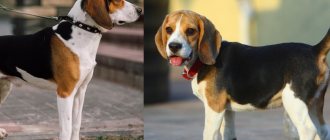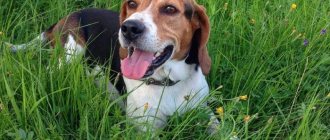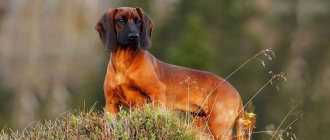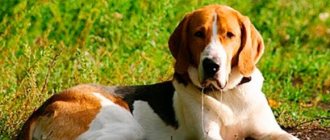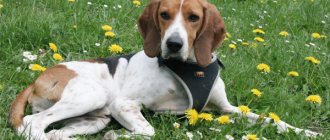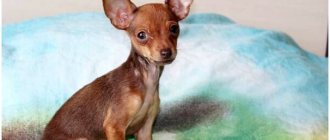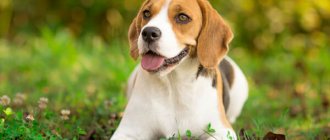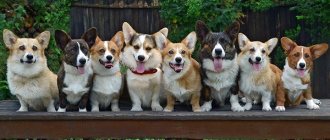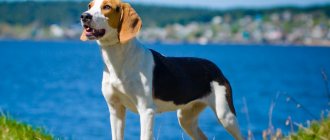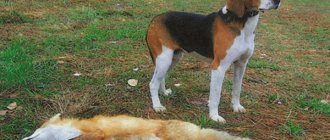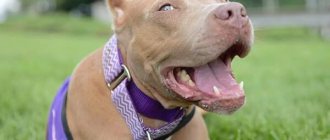Breed standard
The Estonian Hound is a small dog below average height, with a “dry” constitution, a slightly elongated format, and a strong build. In appearance it resembles foxhounds and beagles.
Height at withers: males 45-52 cm, females 42-49 cm Weight: 20-25 kg
Color: black and skewbald with blush, saddleback, brown piebald with blush and crimson piebald are allowed.
- The coat is short, smooth, shiny. The undercoat is not developed.
- The body is muscular, the chest is deep and wide, the back is straight.
- The head is round, the muzzle is straight and long. In profile, the muzzle resembles a rectangle.
- The ears are hanging, close to the head, long.
- The eyes are dark brown, slanted.
- The nose is wide and black.
- The tail is saber-shaped, thick, tapering to the tip. The length in a calm state reaches the hock joints, in movement it rises to the level of the back or slightly higher.
Differences between the Estonian Hound and the Beagle
Many people confuse the Estonian Hound with the Beagle, but they are completely different breeds. The differences are as follows:
- beagles are stockier and stronger;
- the Estonian hound has a narrower muzzle;
- the hound's physique is more elegant and slender;
- The beagle is the ancestor of the Estonian hound.
External differences
It is difficult for ordinary people to distinguish between a beagle and an Estonian hound. Dogs really look alike. But there are several fundamental differences in their exterior.
The Beagle is a small but strong dog with a short, tri-colored coat. The Estonian Hound is larger than its ancestor, proportionally developed, also smooth-haired, but with hard guard hair.
The Beagle is recognized by the FCI, in contrast to the Estonian Hound.
A detailed comparison and differences between the breeds are presented in the table:
History of the breed
In Estonia in the 30s of the twentieth century, work began on breeding this breed.
The reason was the adoption of a law according to which hunting with dogs taller than 45 cm at the withers was prohibited due to environmental measures regarding roe deer.
Therefore, it was decided to “reduce” the Anglo-Russian and Russian hounds by infusing them with the blood of small beagles brought from England. Over time, the blood of small Finnish hounds, Foxhounds and Swiss hounds was added to the new breed.
In 1954, the breed was recognized, and 5 years later the first breed standard was adopted. Today they hunt foxes and hares .
Character and temperament
The Estonian is a passionate hunter with a sharp mind. It is noteworthy that malice towards the animal manifests itself only during the hunt, but at home it is an affectionate, calm and gentle favorite. She is ready to carry out the owner’s orders and approaches a person at the first call.
Pros:
- spiteful towards the beast;
- starts working early;
- capable of persistently pursuing an animal while hunting;
- devoted;
- good-natured and affectionate;
- energetic;
- obedient;
- brave.
Minuses:
- prone to hyperactivity;
- sad without work;
- easily picks up the animal's trail and runs away if he walks without a leash.
Estonian hound and man
Contrary to the belief that hunting dogs are used only for hunting, the Estonian Hound is an excellent companion for an energetic and active person . If you love sports and an active lifestyle and provide your pet with the necessary physical activity, then he will become a devoted friend and companion for you. Of course, life is much better with a hunter, since in this case instincts are realized.
Even city residents get an Estonian hound, provided they have good walking and exercise, or regular hunting trips.
Estonians are tolerant of children. The main thing is to ensure that children do not offend the pet, and then problems will not arise. These dogs are not prone to aggression towards humans.
Representatives of the breed are peaceful and get along well with other pets, provided they grew up with them. If you take an adult hound into a house where a cat or another dog lives, then it is important to properly introduce the old and new residents, otherwise conflicts cannot be avoided.
Who should you choose?
In this case, it would be reasonable to proceed from the purposes for which the dog is purchased.
If you only need a companion, then it is better to choose a beagle, because it is smaller in size, and besides, at present, most lines of this breed have become more decorative than working.
The most popular breed varieties of beagles:
- English;
- American;
- French Beagle Harrier.
If we are talking about purchasing a future hunting assistant, then it is better to choose the Estonian hound, since this breed is still a working breed, which is confirmed by admission to breeding only after successfully passing field tests.
The Beagle and the Estonian Hound are breeds that are similar not only in appearance, but also related in origin.
It was the beagle that “gave” the Estonian hound strong and strong paws and a loud, booming voice.
At present, the Estonian hound has remained mainly a working dog and has retained all its hunting qualities..
The Beagle is now more likely to be just a companion dog than a hunting dog. And, although there are still working lines of this breed, most modern dogs of this breed are simply pets: faithful, devoted and loving to their owners.
Maintenance and care
The Estonian hound does not require complex care, so keeping it in a city apartment is easy: it is delicate, almost does not shed, and is not prone to destruction in the apartment.
The dog's behavior depends on the number of walks and the level of physical activity: if you provide your pet with energetic, long walks, then there will be no problems in the apartment. You need to walk at least 2 times a day for 30-40 minutes , ideally the walk should be accompanied by games and training.
They can only be kept in an enclosure during the warm season; representatives of the breed will not survive the winter outside due to their short fur. In hot weather, the dog needs to be in the shade, although it can withstand high temperatures.
Estonians are unpretentious in food : ready-made industrial feed and natural food are suitable for them. If the animal eats natural food, then include raw meat (beef or poultry), fish, vegetables and fruits in the diet. Fermented milk products, a small amount of cereals, and eggs are also useful. Remember: the portion of a working dog should be larger and more satisfying than a dog that does not hunt.
The Estonian's coat does not require complex care: it is brushed once a month before bathing. Claws are trimmed as they grow. Check floppy ears regularly and clean them with special ear lotions as needed.
Dog training ability
The Estonian Hound responds very well to training if done as early as possible. From about two to three months, it is necessary to gradually begin teaching commands, increasing the intensity of training based on age. The dog has good perseverance and memory. She quickly remembers all the commands and is great at demonstrating them. The Estonian Hound loves to learn, but hunting skills will take quite a long time to develop, practicing them in practice. Therefore, if using a dog for hunting is not a priority, it is better not to fill the dog’s head with unnecessary knowledge.
Beagles, unlike Estonian hounds, are very restless. It will be difficult to teach them commands, since the dog does not like to sit still. She constantly runs, jumps, plays and tries to provoke her owner into action. To train a beagle well, you will need a lot of patience. If the owner does not have it, it is better to leave it to the dog handler. If you neglect to train your dog, it will become uncontrollable both at home and on the street.
Education and training
The Estonian Hound is easy to train and quickly grasps the rules of behavior in the human and canine world. She is sociable, and even a beginner can handle her training. Avoid punishing your dog harshly and socialize it on time.
While eating, practice calling: signal the Estonian puppy with a hunting horn, and when he comes running, feed him. This ability to respond to the sound of a horn will make subsequent training easier.
The puppy will have to go through a training - a type of dog training. It is practiced under the guidance of a specialist or independently when the puppy is 8-9 months . The hunt is carried out early in the morning in September along the black trail, when the tracks of the hare going to bed are still fresh.
The dog, quickly reaching the animal, will pick it up and chase it. The hounds are not immediately sent out to search (crawl): wait 2-3 minutes at the edge of the forest, and then release the dog. Having raised the beast, she must drive it with her voice. If the dog has lost the animal, then the hunter must help find it by tapping the bushes with a stick to scare the animal away, and then send the dog on the trail. The more training is done, the less the hunter helps.
In addition to hunting, the Estonian will easily become a sports dog : she will enjoy running with her owner, agility, freestyle, frisbee, and cycling.
Question of price
Differences also appear in cost. Thus, purebred beagles are sold from 30,000 rubles. The price reaches 60-70 thousand rubles for show class. You can get a puppy for 15-20 thousand rubles.
Estonian hounds are sold cheaper - on average for 15,000 rubles. You can find advertisements with a price of 5-7 thousand rubles.
You can buy beagles in the following nurseries:
- https://www.kennel-beagle.rf – St. Petersburg;
- https://www.beaglevista.com – Moscow.
“Estonians” are bred by the following breeders:
- https://sobaki.pro/index.php?m=Poroda&page=Poroda/Pitomniki&id=Esto&pit=2749 – nursery “Nazoro” in Moscow;
- https://iztsarevshchiny.rf – Samara region.
Health and life expectancy
Representatives of the breed live 10-12 years . They are distinguished by excellent health and are prone to only a few diseases:
- otitis due to drooping ears;
- arthritis due to heavy load on the joints.
It is important to protect a hunting dog that constantly works in the forest from bites of ticks that carry piroplasmosis and receive timely vaccinations.
Breed photo
A selection of photos of the Estonian hound.
External differences
It is difficult for ordinary people to distinguish between a beagle and an Estonian hound. Dogs really look alike. But there are several fundamental differences in their exterior.
The Beagle is a small but strong dog with a short, tri-colored coat. The Estonian Hound is larger than its ancestor, proportionally developed, also smooth-haired, but with hard guard hair.
The Beagle is recognized by the FCI, in contrast to the Estonian Hound.
A detailed comparison and differences between the breeds are presented in the table:
